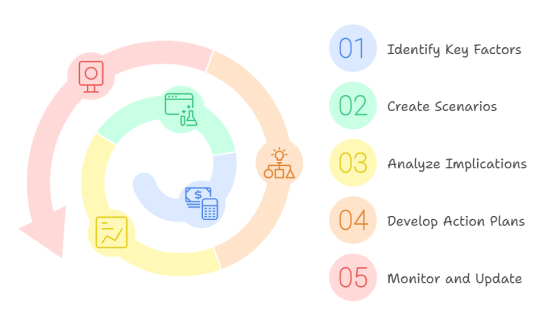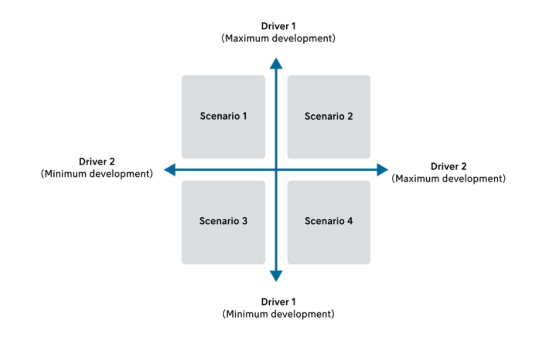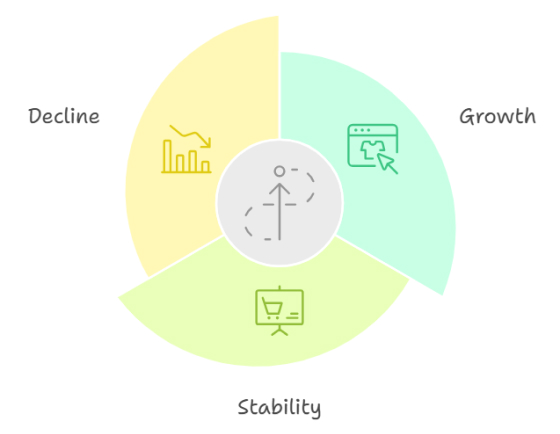The modern business world is full of uncertainties. Both markets and customers change quickly, creating unexpected challenges for businesses. How can companies stay prepared? One solution is scenario planning. This strategy helps businesses think ahead. It prepares them for different outcomes and supports smarter decision-making.
What is scenario planning?
Scenario planning helps businesses prepare for the future. It does not guess what will happen but looks at many possible outcomes.
For example, businesses think about:
- What if the market grows?
- What if it slows down?
- What if competitors release similar products?
- What if new rules are introduced?
- What if customer preferences change?
By considering these situations, they find risks and chances. This helps businesses plan smarter and choose better actions.
Why do businesses use scenario planning?
The future is always unclear. No one can know it for sure. Scenario planning helps businesses deal with this uncertainty. It lets them prepare for different possibilities.
Here’s why it’s so important:
- Proactive preparation: Businesses can identify potential changes early and prepare strategies in advance. This helps them to plan and act early instead of reacting to problems as they arise.
- Better decision-making: Considering multiple scenarios ensures that decisions are not based on assumptions or guesswork. This leads to more informed and effective strategies.
- Risk management: Companies can identify risks in different scenarios and create plans to reduce their impact, reducing the chances of being caught off guard.
- Team alignment: Scenario planning brings teams together to talk about future possibilities. It ensures everyone understands the plan and works towards the same goals.
- Increased flexibility: With plans in place for different situations, businesses can adapt quickly if unexpected events occur.
How does scenario planning work?

The scenario planning process involves several key steps. Let’s break it down into a simple guide:
Step 1: Identify key factors
Start by identifying the major factors that could impact your business. These factors might include:
- Economic trends
- Market demands
- Competitor actions
- Technological changes
- Regulatory updates
For example, a tech company might focus on artificial intelligence advancements. These advancements could revolutionize their products. They might also consider how upcoming data privacy laws could affect their operations.
Step 2: Create scenarios
Develop a set of plausible scenarios based on the key factors. Each scenario should describe a different version of the future. For example:
- Best-case scenario: The market grows, and customer demand increases.
- Worst-case scenario: A new competitor dominates the market.
- Neutral scenario: The market remains stable, with minimal changes.
These scenarios should be realistic and highlight both challenges and opportunities. Organizations can use scenario planning matrix and scenario planning software like Lucidchart, PlanGuru, and Tableau to help this process.

Scenario Planning Matrix – https://www.futuresplatform.com/blog/2×2-scenario-planning-matrix-guideline
Step 3: Analyze implications
For each scenario, analyze its impact on your business. Ask questions like:
- How would this scenario affect our operations?
- What opportunities could it create?
- What risks would we face?
This step helps you understand what to prepare for in each situation.
Step 4: Develop action plans
Create strategies and action plans for each scenario. These plans should outline specific steps to take if the scenario becomes a reality. For example:
- In the best-case scenario, The company might increase production and marketing efforts.
- In the worst-case scenario, The company might focus on cost-cutting and finding new markets.
Step 5: Monitor and update
Scenario planning is not a one-time activity. Businesses must revisit their scenarios regularly. Plans should be updated when new information or data is available. For example, a new competitor might enter the market. Then, you might need to recheck and adjust your plans.
Benefits of scenario planning
Scenario planning offers numerous benefits for businesses:
- Improved preparedness: Companies can explore different possibilities. This helps them prepare for a wide range of outcomes. It reduces uncertainty and boosts confidence in decision-making.
- Enhanced agility: They can adapt more quickly to changes when businesses have plans for various scenarios. This agility is crucial in competitive markets.
- Strategic focus: Scenario planning helps businesses stay focused on long-term goals. It prevents distractions from short-term issues.
- Risk reduction: Identifying potential risks in advance helps companies create mitigation strategies. This minimizes the impact of unexpected events.
- Team collaboration: Scenario planning brings teams together to discuss future possibilities. It fosters collaboration and ensures everyone understands the business’s priorities.
Challenges of scenario planning
Scenario planning is a powerful tool. However, it’s not without challenges:
- Time-consuming: Developing scenarios requires significant time and resources. Businesses must balance this with daily operations.
- Uncertainty in assumptions: Scenarios rely on assumptions. These assumptions may not always be accurate. Businesses must stay flexible and adjust their plans when needed.
- Complexity: Some scenarios can be highly complex, involving many interconnected factors. Simplifying these scenarios without losing important details can be challenging.
Real-world examples

Imagine a retail company planning for the next five years. They use scenario planning to explore three possible futures:
Scenario 1: Growth
E-commerce is growing rapidly. Customers now prefer online shopping. The company invests in digital marketing. It also focuses on improving logistics.
Scenario 2: Stability
Both online and offline sales remain steady. The company focuses on improving customer experience in stores and online.
Scenario 3: Decline
Economic downturns reduce consumer spending. The company cuts costs and focuses on essential products to maintain profitability.
By preparing strategies for each scenario, the company ensures it can succeed regardless of the future.
Conclusion
Scenario planning is essential for businesses facing an uncertain future. It helps explore multiple outcomes and prepares companies for challenges and opportunities. Although this requires some effort, the benefits are greater than the costs. Businesses using scenario planning adapt more easily. They are more likely to thrive and succeed long-term.
